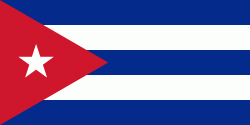Artemisa Province (Artemisa)
Artemisa was the largest city and municipality of the former La Habana Province. The newly formed province combined the eight western municipalities of La Habana Province and three eastern municipalities of neighbor province Pinar del Río (Bahía Honda, Candelaria and San Cristóbal). The capital and largest city is Artemisa (47,000 pop. in 2015).
The new province is only larger than Havana city and Mayabeque, but with more population than four other Cuban provinces. It is the most densely populated, after Havana city and Santiago de Cuba.
The economy of the Artemisa province is based mainly on agriculture (fruits, potatoes, rice, vegetables, sugar cane) and industry of building materials (two cement factories), food processing industry and power plants. It contains the important port of Mariel in the northern coast. The province is also important in the military sector with the main Cuban Air Force base (San Antonio de los Baños) the Western base of the Cuban Navy (Cabañas Bay) and the Military Academy (College) "Antonio Maceo" in Caimito.
Map - Artemisa Province (Artemisa)
Map
Country - Cuba
 |
 |
| Flag of Cuba | |
The territory that is now Cuba was inhabited by the Ciboney people from the 4th millennium BC with the Guanahatabey and Taíno peoples until Spanish colonization in the 15th century. From the 15th century, it was a colony of Spain, and slavery was abolished in 1886, remaining a Spanish colony until the Spanish–American War of 1898, when Cuba was occupied by the United States and gained independence in 1902. In 1940, Cuba implemented a new constitution, but mounting political unrest culminated in a coup in 1952 and the subsequent dictatorship of Fulgencio Batista, which was later overthrown in January 1959 by the 26th of July Movement during the Cuban Revolution, which afterwards established communist rule under the leadership of Fidel Castro. The country was a point of contention during the Cold War between the Soviet Union and the United States, and a nuclear war nearly broke out during the Cuban Missile Crisis of 1962. Following the collapse of the Soviet Union, Cuba faced a severe economic downturn in the 1990s, known as the Special Period. In 2008, Fidel Castro resigned after 49 years of leadership of Cuba and was replaced by his brother Raúl Castro.
Currency / Language
| ISO | Currency | Symbol | Significant figures |
|---|---|---|---|
| CUC | Cuban convertible peso | $ | 2 |
| CUP | Cuban peso | $ | 2 |
| ISO | Language |
|---|---|
| ES | Spanish language |
















